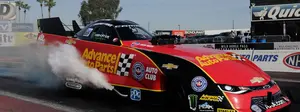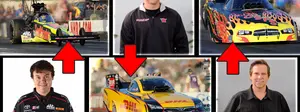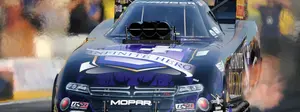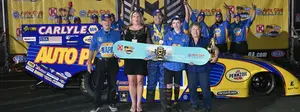

Top Alcohol history lesson
The Denso Spark Plugs NHRA Nationals was the 600th race in the history of the Top Alcohol Dragster and Top Alcohol Funny Car categories. Let's take a look back at how it all started.
The Top Alcohol Dragster and Top Alcohol Funny Car classes have long been the third- and fourth-fastest NHRA-legal categories, and they have provided a great show as a part of NHRA Mello Yello Drag Racing Series events and as headliners at NHRA Lucas Oil Drag Racing Series events. Drivers have risen to worldwide prominence with stand-alone success in the alcohol ranks, and countless others have used experience in the fast, competitive classes as a stepping stone or training ground for careers in the Top Fuel or Funny Car ranks.
Pro Comp was formed to both lure in the ample amount of dragster and Funny Car racers who did not want to compete in a handicap-start system against econo dragsters and the like in Comp and to help fill the void left by the demise of the Top Gas category and the tail-end of the A/Gas Superchaged era. There were a good amount of cars already racing in Ken Veney’s and Dale Armstrong’s Southern California Injected Funny Car Association on the West Coast, such as Veney and Armstrong themselves and “Wild” Wilfred Boutilier.
Championships were awarded from 1974 to 1980, during which the titlists were decided not by the current points system but by the winner of the NHRA Finals event. Eventually, the consistency of dragsters as opposed to Funny Cars left some longtime Funny Car campaigners frustrated, and the dragster dominance late in the Pro Comp era led to the two classes being separated after the 1980 season. Nine different types of dragsters combined to form the Top Alcohol Dragster class, and four different Funny Car combinations were allotted in Top Alcohol Funny Car. The new categories competed in a championship system that combined points from national and divisional races, a model similar to what is used today.
Blown alcohol combinations evolved greatly from a performance standpoint, from the first six-second run in 1975 to the 5.1-second, 270-plus-mph dragsters and the 5.3-second, 270-mph Funny Cars that compete today. Parts became more specialized to the combinations, such as the development of fathead cylinder heads run by Hemi combinations, parts became available in higher-quality materials over time, and new technology was developed. Blowers went through a great deal of development, particularly during the “blower war” era of the late 1980s and early 1990s where competitors went from standard Roots-type blowers to hi-helix superchargers with more twist and finally arriving at the screw compressors that are common today.
While the racers in the Top Alcohol Funny Car class essentially conformed to one type of combination, their dragster counterparts whittled down into two major distinctions: blown and A/Fuel. Rules changes to ensure parity have been taking place since some A/Fuelers began making runs that were seemingly out of reach for a blown combination in the early ‘90s. There was a great deal of debate among racers regarding what determines a level playing field, because the A/Fuelers had more performance potential but were inconsistent and not winning races at the time. Entries such as the Adams & Enriquez A/Fueler at the 1992 NHRA Finals and Tom Topping’s dragster began resetting the national records significantly during prime national event conditions, and NHRA compensated by regulating the minimum weight and gear ratios of the A/Fuelers. This process continued as drivers such as Keith Stark and Chess Bushey continued to raise the performance bar on injected nitro, and many blown stalwarts began switching over to the A/Fuel combination.
The most common method of performance regulation for A/Fuelers of the modern era is limiting the maximum amount of nitromethane percentage in the fuel mixture. That method was employed for the first time in 2005 following Mitch Myers' incredible 5.10 run at the season-ending event in 2004. The rules have been steady since the 2014 season when they were given a maximum of 95 percent nitro.
Top 10 winningest drivers
Top Alcohol Dragster
Top Alcohol Funny Car
The Top Alcohol Dragster and Top Alcohol Funny Car classes have long been the third- and fourth-fastest NHRA-legal categories, and they have provided a great show as a part of NHRA Mello Yello Drag Racing Series events and as headliners at NHRA Lucas Oil Drag Racing Series events. Drivers have risen to worldwide prominence with stand-alone success in the alcohol ranks, and countless others have used experience in the fast, competitive classes as a stepping stone or training ground for careers in the Top Fuel or Funny Car ranks.

Pro Comp was formed to both lure in the ample amount of dragster and Funny Car racers who did not want to compete in a handicap-start system against econo dragsters and the like in Comp and to help fill the void left by the demise of the Top Gas category and the tail-end of the A/Gas Superchaged era. There were a good amount of cars already racing in Ken Veney’s and Dale Armstrong’s Southern California Injected Funny Car Association on the West Coast, such as Veney and Armstrong themselves and “Wild” Wilfred Boutilier.

Brad Anderson won titles as a driver in 1984, 1985, and 1989.
Championships were awarded from 1974 to 1980, during which the titlists were decided not by the current points system but by the winner of the NHRA Finals event. Eventually, the consistency of dragsters as opposed to Funny Cars left some longtime Funny Car campaigners frustrated, and the dragster dominance late in the Pro Comp era led to the two classes being separated after the 1980 season. Nine different types of dragsters combined to form the Top Alcohol Dragster class, and four different Funny Car combinations were allotted in Top Alcohol Funny Car. The new categories competed in a championship system that combined points from national and divisional races, a model similar to what is used today.

Frank Manzo, pictured in 1981, is the winningest Sportsman driver in history with 105 event wins and 17 season titles.
In the 1982 season, the classes were reunited in a system where Top Alcohol Dragsters and Funny Cars qualified and raced separately, and the two winners raced each other to determine an overall Pro Comp winner. As dragsters won eight of 11 final rounds, the format was vanished after one year, and the two categories were separated for good.Blown alcohol combinations evolved greatly from a performance standpoint, from the first six-second run in 1975 to the 5.1-second, 270-plus-mph dragsters and the 5.3-second, 270-mph Funny Cars that compete today. Parts became more specialized to the combinations, such as the development of fathead cylinder heads run by Hemi combinations, parts became available in higher-quality materials over time, and new technology was developed. Blowers went through a great deal of development, particularly during the “blower war” era of the late 1980s and early 1990s where competitors went from standard Roots-type blowers to hi-helix superchargers with more twist and finally arriving at the screw compressors that are common today.
While the racers in the Top Alcohol Funny Car class essentially conformed to one type of combination, their dragster counterparts whittled down into two major distinctions: blown and A/Fuel. Rules changes to ensure parity have been taking place since some A/Fuelers began making runs that were seemingly out of reach for a blown combination in the early ‘90s. There was a great deal of debate among racers regarding what determines a level playing field, because the A/Fuelers had more performance potential but were inconsistent and not winning races at the time. Entries such as the Adams & Enriquez A/Fueler at the 1992 NHRA Finals and Tom Topping’s dragster began resetting the national records significantly during prime national event conditions, and NHRA compensated by regulating the minimum weight and gear ratios of the A/Fuelers. This process continued as drivers such as Keith Stark and Chess Bushey continued to raise the performance bar on injected nitro, and many blown stalwarts began switching over to the A/Fuel combination.

The most common method of performance regulation for A/Fuelers of the modern era is limiting the maximum amount of nitromethane percentage in the fuel mixture. That method was employed for the first time in 2005 following Mitch Myers' incredible 5.10 run at the season-ending event in 2004. The rules have been steady since the 2014 season when they were given a maximum of 95 percent nitro.
Top 10 winningest drivers
Top Alcohol Dragster
1.
2.
3.
4.
6.
7.
8.
9.
10.
Top Alcohol Funny Car
1.
2.
3.
4.
5.
6.
7.
8.
10.



























